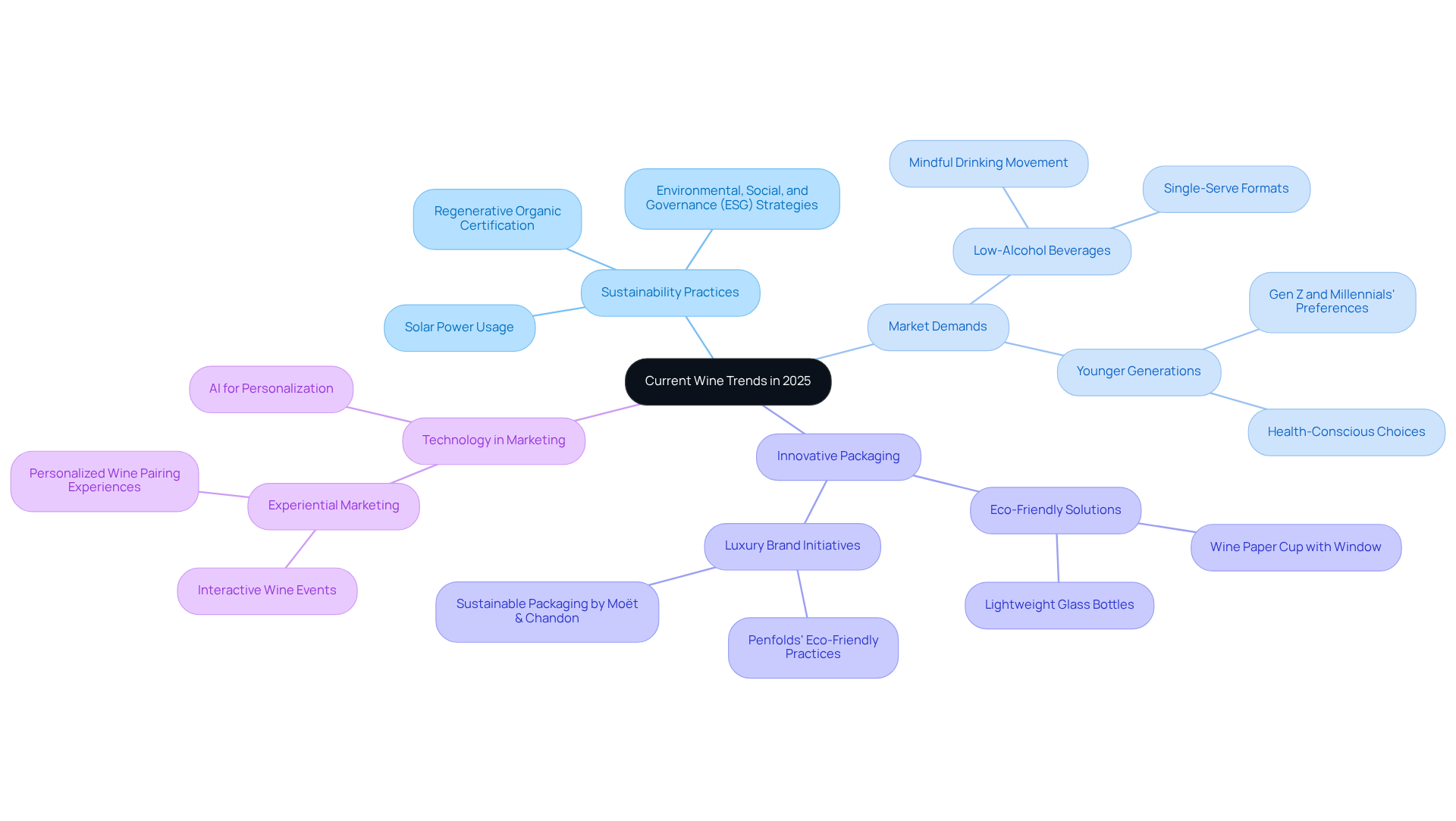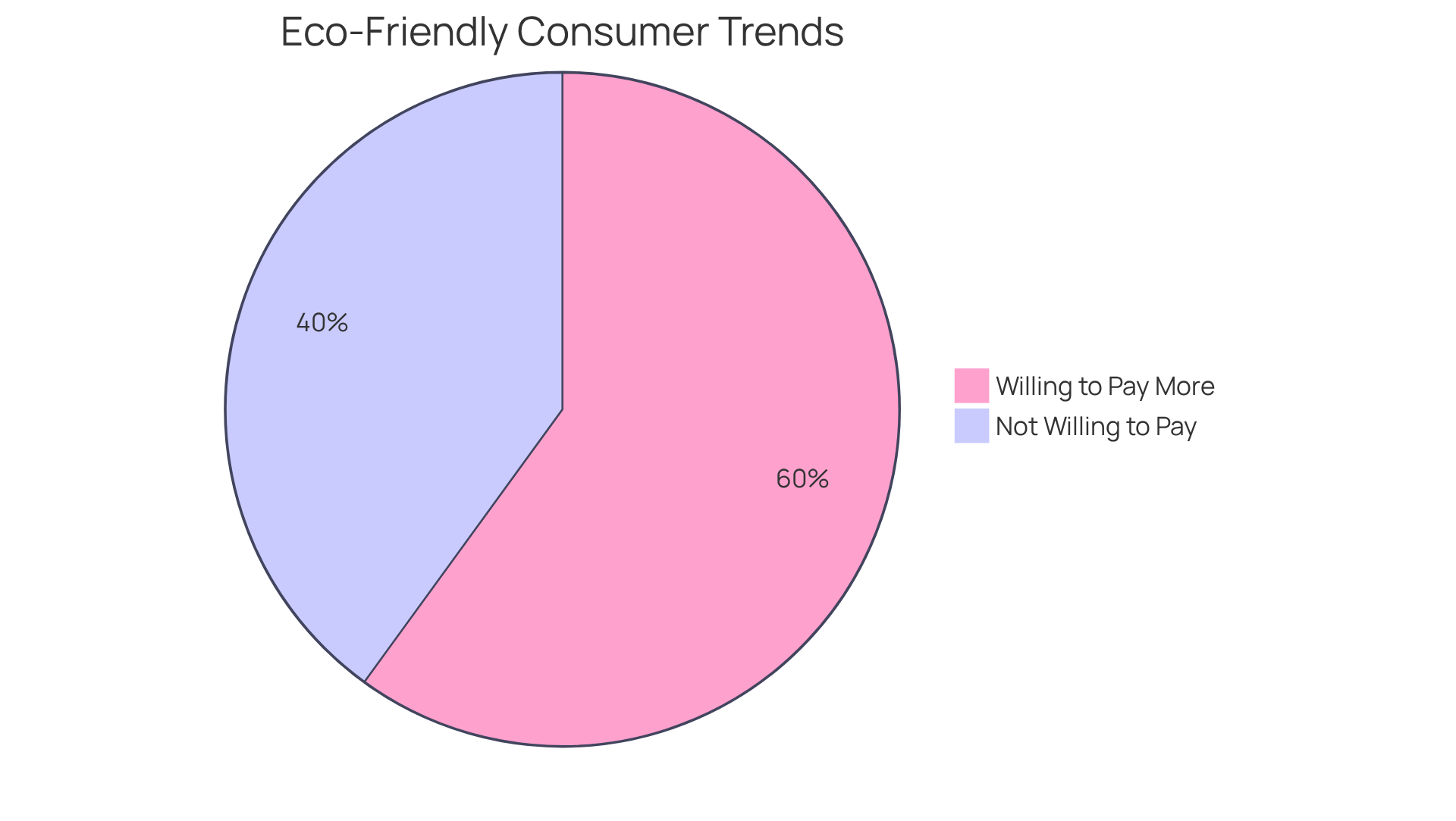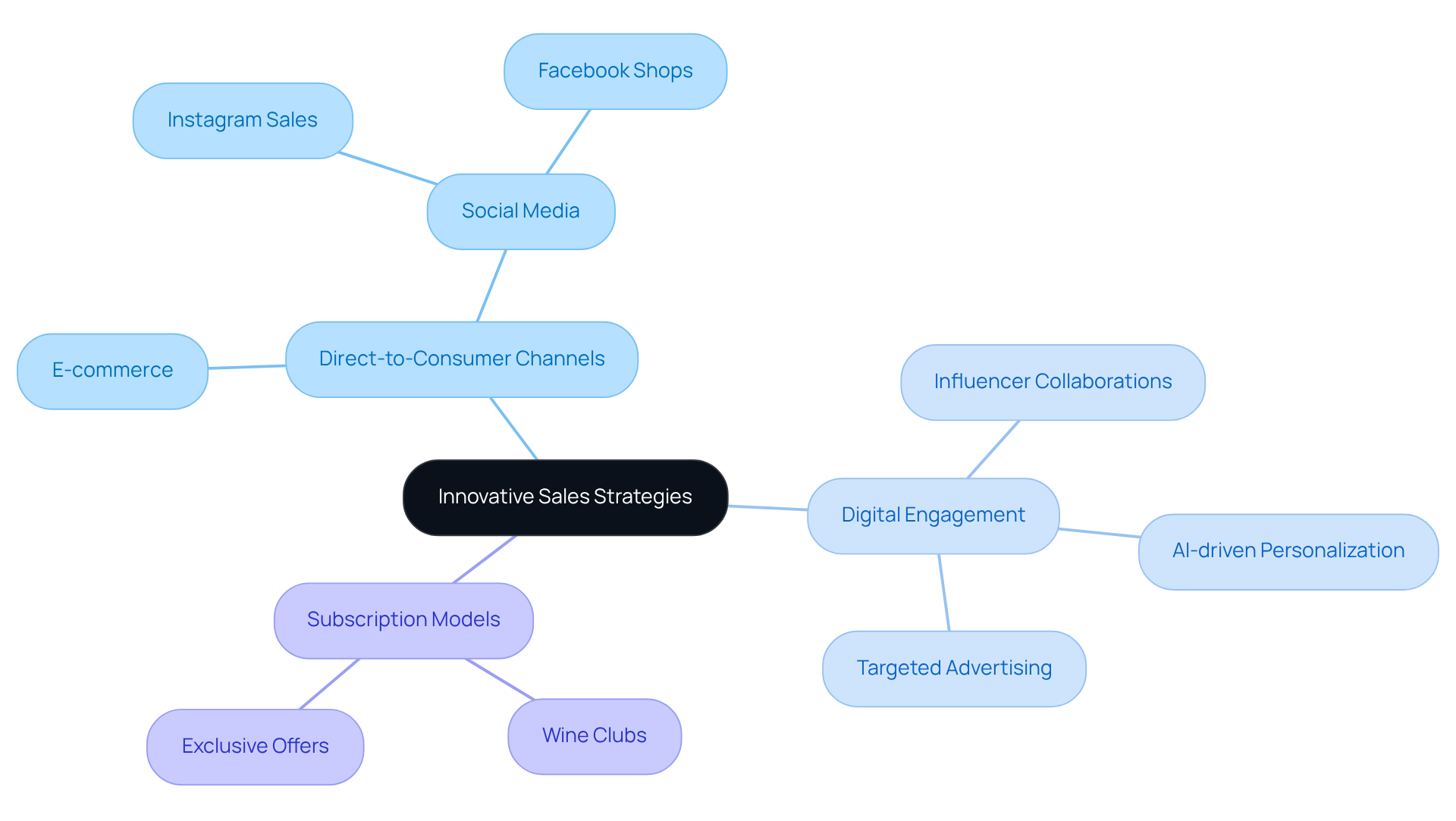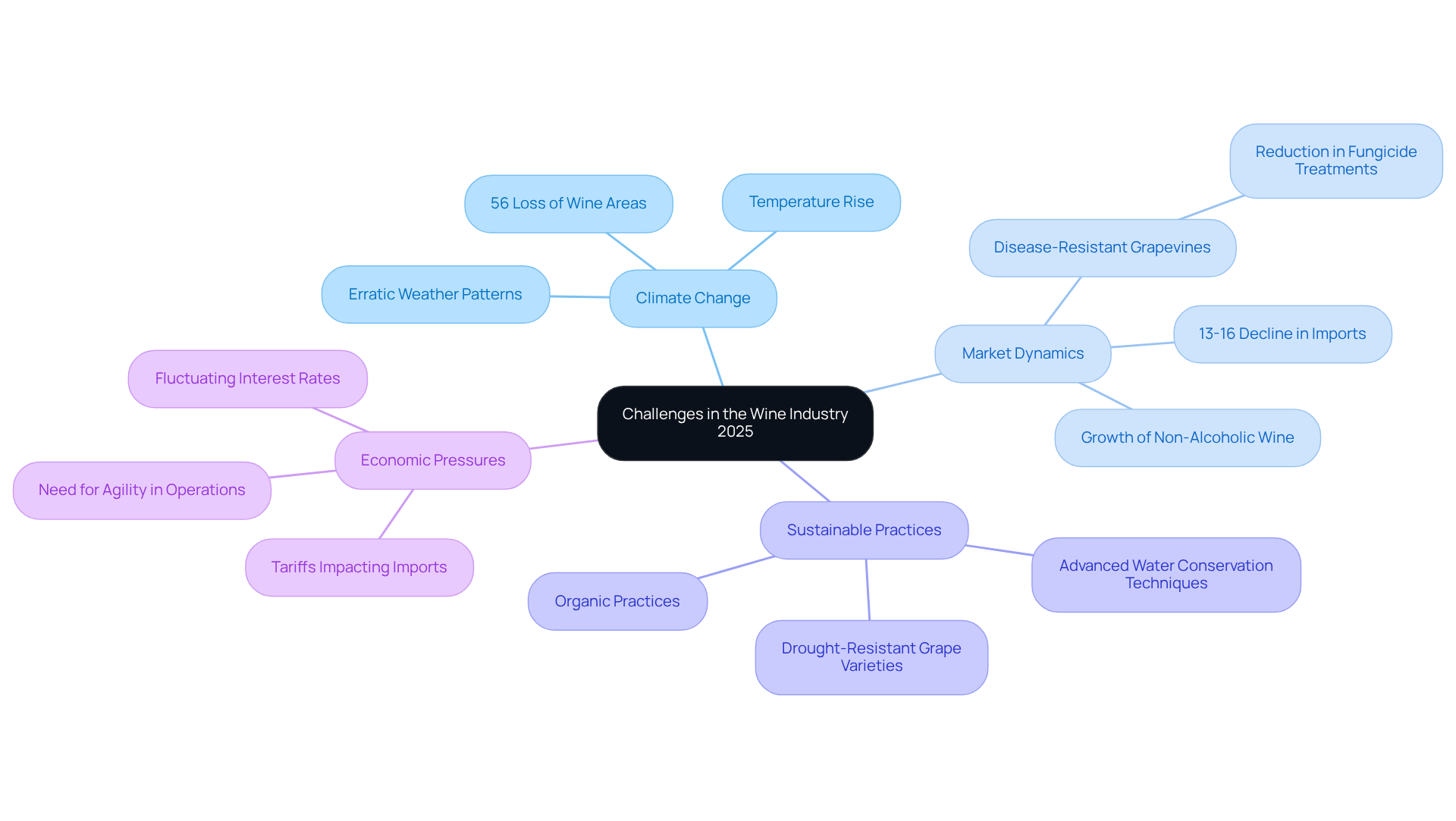Overview
The article primarily investigates the prevailing wine trends for 2025, with a particular emphasis on sustainability, health consciousness, and innovative marketing strategies. It establishes that wineries are proactively adapting to these trends by:
- Implementing eco-friendly practices
- Promoting low-alcohol options
- Leveraging technology for direct-to-consumer engagement
This alignment with the evolving preferences of health-conscious and environmentally aware consumers underscores the necessity for wineries to evolve in a competitive market.
Introduction
The wine industry is undergoing a transformative shift as it adeptly navigates the complexities of consumer preferences and environmental challenges in 2025. With sustainability and health consciousness at the forefront, wineries are evolving their practices to resonate with a new generation of eco-aware consumers. As the market continues to evolve, producers must consider:
- How can they effectively align their strategies with these emerging trends to ensure growth?
- How can they foster loyalty in an increasingly competitive landscape?
Defining Current Wine Trends in 2025
Current wine trends in 2025 underscore significant shifts in buyer preferences, production techniques, and marketing approaches, driven by a heightened focus on sustainability and health awareness. Wineries are increasingly embracing sustainable practices, exemplified by Stag’s Leap Wine Cellars achieving Regenerative Organic Certification and Charles Krug winery harnessing solar power for 80% of its production. These initiatives not only mitigate environmental impact but also resonate with eco-conscious consumers who prioritize sustainability in their purchasing decisions.
The surging demand for low-alcohol and non-alcoholic beverages is reflecting current wine trends that favor moderation and mindful drinking. The non-alcoholic wine market is projected to grow at a compound annual growth rate of 10.4%, reaching a value of $3.78 billion by 2030. Younger generations, including Gen Z and millennials, are particularly drawn to current wine trends as they are increasingly concerned about the environmental impact of their choices and seek beverages that align with their values.
Innovative packaging solutions are gaining traction, with wineries exploring lightweight glass bottles and eco-friendly alternatives to traditional packaging. The Wine Paper Cup with Window exemplifies this shift, offering a compostable and customizable option that meets the needs of environmentally conscious individuals. The industry is witnessing current wine trends as luxury brands such as Moët & Chandon and Penfolds adopt sustainable packaging methods, focusing on minimizing carbon footprints and enhancing customer experiences.
Technology is pivotal in shaping wine marketing strategies, with sommeliers leveraging AI to deliver personalized wine pairing experiences and producers hosting interactive events that engage consumers in the crafting process. This emphasis on storytelling and experiential marketing is essential for fostering brand loyalty and connecting with a diverse audience. By employing established direct-to-consumer strategies, such as targeted marketing campaigns and personalized customer experiences, producers can convert casual buyers into dedicated club members, ensuring consistent growth and sustainable revenue.
Furthermore, strategic capital planning is vital for family-owned vineyards navigating these evolving patterns. By securing appropriate capital for expansion and innovation, wine producers can invest in sustainable practices and enhance their direct-to-consumer channels. As the beverage sector adapts to current wine trends, it is imperative for producers to refine their strategies to meet the demands of a health-conscious and environmentally aware clientele. By integrating sustainability into their business models and embracing innovative practices, wineries can position themselves for success in a competitive landscape.

Consumer Preferences: Health Consciousness and Sustainability
In 2025, health awareness significantly influences purchasing habits within the beverage sector. This notable shift towards lower-alcohol options and beverages with minimal additives exemplifies current wine trends that align with a broader trend of mindful drinking. Approximately 60% of millennial and Gen Z consumers are willing to pay a premium for eco-friendly products, thereby driving the demand for organic and biodynamic beverages. This preference is further supported by projections indicating that the global organic beverage market is expected to triple by 2030, as individuals increasingly seek products that resonate with their principles of sustainability and health.
Sustainability has emerged as a pivotal concern, compelling wineries to adopt eco-friendly packaging and regenerative farming practices that align with current wine trends to meet evolving consumer expectations. The rise of low-intervention beverages, perceived as healthier and more authentic, underscores the importance of aligning product offerings with current wine trends and these shifting preferences. For instance, organic sparkling beverages are experiencing a surge in popularity, prompting U.S. producers to ramp up domestic production. Wineries that embrace are strategically positioning themselves to enhance brand loyalty and capture a larger market share in an increasingly competitive landscape.

Innovative Sales Strategies: Direct-to-Consumer and Digital Engagement
In 2025, current wine trends are fundamentally transforming the beverage industry, particularly through a pronounced emphasis on innovative sales strategies and direct-to-consumer (DTC) channels. Wineries are strategically leveraging and social media to forge deeper connections with consumers, crafting personalized experiences that significantly enhance brand loyalty.
This evolution is further propelled by the increasing appeal of subscription models and wine clubs, which allow vineyards to cultivate lasting relationships with their customers. Digital engagement strategies, including targeted advertising and influencer collaborations, are proving particularly effective in resonating with younger demographics.
For example, establishments employing AI-driven personalization in their marketing initiatives have reported substantial increases in customer engagement and sales. This shift towards digital marketing is not merely a trend; it is an essential strategy for vineyards aiming to thrive in a competitive landscape, especially given the current wine trends that highlight the growing consumer preference for home delivery and seamless online shopping experiences.

Navigating Challenges: Climate Change and Market Dynamics
The wine industry in 2025 faces formidable challenges, predominantly driven by climate change and shifting market dynamics. Research indicates that rising temperatures and erratic weather patterns could lead to the loss of 56% of the globe's wine-producing areas under a 2 °C warming scenario. This alarming statistic underscores the urgent need for producers to reassess their vineyard management strategies. In response, vineyards are increasingly adopting sustainable practices, incorporating advanced water conservation techniques and cultivating drought-resistant grape varieties.
Economic pressures compound these challenges, with a projected 13 to 16 percent decline in imports due to tariffs and fluctuating interest rates. This situation necessitates agility in vineyard operations. By embracing innovation and sustainability, producers not only navigate the challenges posed by current wine trends effectively but also position themselves as frontrunners in a rapidly evolving market. Notably, the introduction of disease-resistant grapevines has enabled a remarkable reduction in fungicide treatments by over 90%, as evidenced by research from INRAE and Bordeaux Sciences Agro.
As the industry adapts to current wine trends, the emphasis on organic practices—expected to reach $12.4 billion in global sales—alongside transparency, is likely to resonate with consumers, thereby enhancing brand loyalty and driving growth. To capitalize on these trends, family-owned wineries can leverage Enocap's , which unlock growth opportunities through tailored debt, equity, and acquisition solutions. Furthermore, Enocap provides effective direct-to-consumer strategies, such as personalized marketing campaigns and membership programs, aimed at transforming casual buyers into loyal club members through compelling brand storytelling.

Conclusion
Current wine trends in 2025 reveal a transformative landscape where sustainability, health consciousness, and innovative marketing strategies take center stage. Wineries must adapt to these shifts, making the integration of eco-friendly practices and consumer-centric approaches essential for success. By embracing these evolving preferences, producers can enhance their market presence and foster deeper connections with a discerning clientele.
The article highlights several key aspects shaping the wine industry today:
- Sustainable practices are no longer optional; they resonate deeply with environmentally aware consumers.
- The rise of low-alcohol and non-alcoholic options reflects a broader movement towards mindful drinking, particularly among younger generations.
- Innovative sales strategies, including direct-to-consumer models and digital engagement, are crucial for building brand loyalty and navigating the competitive market.
Wineries that prioritize these trends will be well-positioned to thrive amid the challenges posed by climate change and economic fluctuations.
Ultimately, the future of the wine industry hinges on the ability of producers to align their offerings with the values of health-conscious and eco-friendly consumers. By adopting sustainable practices, embracing innovative technologies, and focusing on personalized marketing, wineries can not only meet the demands of today's market but also contribute positively to the environment. As the industry evolves, the commitment to sustainability and consumer engagement will be the cornerstone of long-term success in the dynamic world of wine.
Frequently Asked Questions
What are the main current wine trends in 2025?
The main trends include a focus on sustainability, the rise of low-alcohol and non-alcoholic beverages, innovative packaging solutions, and the use of technology in marketing and consumer engagement.
How are wineries addressing sustainability in their practices?
Wineries are adopting sustainable practices, such as Stag’s Leap Wine Cellars achieving Regenerative Organic Certification and Charles Krug winery using solar power for 80% of its production, which helps reduce environmental impact and appeals to eco-conscious consumers.
What is the projected growth of the non-alcoholic wine market?
The non-alcoholic wine market is projected to grow at a compound annual growth rate of 10.4%, reaching a value of $3.78 billion by 2030.
Which demographics are particularly interested in current wine trends?
Younger generations, including Gen Z and millennials, are particularly drawn to these trends due to their concerns about environmental impact and their preference for beverages that align with their values.
What innovative packaging solutions are being explored in the wine industry?
Wineries are exploring lightweight glass bottles and eco-friendly alternatives, such as the Wine Paper Cup with Window, which is compostable and customizable.
How is technology influencing wine marketing strategies?
Technology is being used to enhance marketing strategies through AI-driven personalized wine pairing experiences and interactive events that engage consumers in the crafting process.
What role does storytelling and experiential marketing play in the wine industry?
Storytelling and experiential marketing are essential for fostering brand loyalty and connecting with a diverse audience, helping producers convert casual buyers into dedicated customers.
Why is strategic capital planning important for family-owned vineyards?
Strategic capital planning is vital for family-owned vineyards to secure funding for expansion and innovation, allowing them to invest in sustainable practices and enhance their direct-to-consumer channels.
How can wineries position themselves for success in the competitive landscape?
Wineries can position themselves for success by integrating sustainability into their business models, embracing innovative practices, and refining their strategies to meet the demands of health-conscious and environmentally aware consumers.




